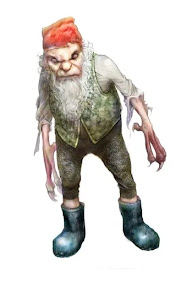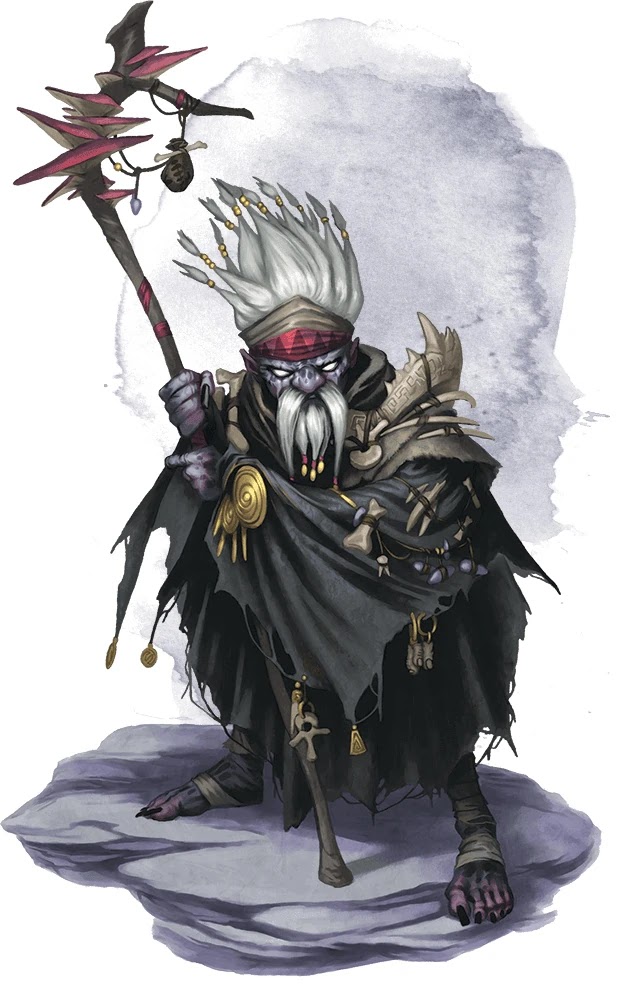Advanced fungal parasites the Half-Folk parasitize not a singular host body, but a community and a culture. Each colony of half-folk produces blooms which have a humanoid shape and act as the colony's agents in the world. The colonies do their best of hide their fungal nature from the rest of the world as an act of societal camouflage. Up until now this has worked remarkably well, as all but the occasional wizard cursed with the gift of clairvoyance know of the fungal nature of a single kind of Half-Folk. Let alone the shared nature of them all.
Created when Bwyd, the elemental spirit of mushrooms, stole a mote of raw creation from the other elemental lords. It used that mote to become a mockery of mortal life as it had been wrought. Destined to live in the shadow of mortalkind, Bwyd spawned its own versions of each kind it encountered. These Half-Folk are known as the following.
The Half-Folk of Elves are known as Gnomes
The Half-Folk of Dwarves are known as Dero
The Half-Folk of Humans are known as Halflings
The Half-Folk of Orcs are known as Hobgoblins
The Half-Folk of the wilds are known as Goblins
Bloom Appearance: Squat long eared humanoid with spindly arms and legs, often a beard, sometimes wear red caps.
Tendencies: Territorial and vicious, carnivorous
Culture: Warlike, often used by the elves as scouts in their conflicts. Those who wear red caps are the worst of them all, constantly redying their headwear in fresh blood.
Burrow Shape: Open cavern with sharp wood-like spike mushrooms lining the floor. Mycelial networks encourage moss growth to hide their nature.
Colony Characteristics: Subservient to elves. Often times a Gnomish colony will be purposefully cultivated by an elvish gardener in order to grow new scouts.
Bloom Production: Gnomish blooms form best in iron rich environments with heavy moisture. Oftentimes this is inside a host body which has been stabbed with one of the wooden spike mushrooms that the gnomes use as weapons. Otherwise blooms can be produced by a careful gardener leaving a body to rot where the spike mushrooms are dense. A standard human corpse can spawn 1d4 Gnomes over the course of 2d6 weeks.
Lifespan: A Gnomish bloom will live for anywhere from 5-40 years depending on how often it feeds. After it dies there is a 1% chance that the site of its death will spawn a new Gnomish colony
Bloom Appearance: Grey-skinned bearded men with pure white eyes and a cubic stature. When motionless, appear to be statues
Tendencies: Inquisitive and reclusive
Culture: Working off the backs of the Qevish empire most dero stay out of sight as often as possible. Working alongside criminal elements of the empire in exchange for various materials useful to the colony.
Burrow Shape: Bare stone-like networks cover what appears to be a completely natural cavern. A number of bulbous growths scattered around the floor like softly glowing leather sacks. These sacks contain a number of substances useful for trade or for defense of the colony.
Colony Characteristics: Some of the most chemically complex colonies. Dero colonies will collect strange plants, minerals, fungi, or animals for their experiments. These colonies are able to decompose most of a creature's body while also maintaining the specific organ it needs to produce certain compounds. In turn it synthesizes these compounds into drugs, poisons, and salves that are impossible to recreate.
Bloom Production: Blooms are created with the excess material caused by the decomposition of foreign bodies. In times of need a colony will rapidly consume its stockpiled organs to defend the colony or to procure food with new blooms.
Lifespan: Dero blooms live on average 90-120 years, though few reach that age. Oftentimes a dero bloom will die violently in the process of trying to capture a powerful beast or deal with a dangerous criminal. In which case the colony will try and recover the materials of the corpse with non-bloom labor
Bloom Appearance: Squat hairy men with giant feet and bulbous faces.
Tendencies: Passive and care-free (sneaky and treacherous in times of need)
Culture: Vaguely supportive of the nearest human settlement, working skilled trades as possible. Otherwise they tend to farm a wide variety of plants that contain nutrients the colony can't normally produce.
Burrow Shape: Cozy wooden structures with no obvious signs of its nature, especially as the blooms decorate them with human detritus as an advanced form of camouflage.
Colony Characteristics: Some of the smartest colonies, able to learn trades and produce blooms with those trades as long as the colony survives. Most self sufficient if its host settlement dies, but is always at risk of goblinification. May turn to thievery in times of trouble. It is not unheard of multiple colonies merging together into villages of halflings. Each bloom of a specific colony considers the other blooms to be their family, even considering one or two blooms to be "parents" despite the nature of their spawning.
Bloom Production: Halfling blooms are formed whenever resources are plentiful enough for them to do so. They spawn asexually in the "cellars" of the colony. The colony manages the skills of its blooms much the same way a dero colony manages its chemical compounds. Ensuring a balance of community that can keep it safe and prosperous in the shadow of a larger human settlement.
Lifespan: Halfling Blooms tend to live for 60-90 years, at which point they are buried near the colony and allowed to reabsorb.
Bloom Appearance: Tallest of the half-folk blooms, a hobgoblins holds a somewhat dense structure while averaging about 4'6"-5'2" in height. Details of their appearance change depending on their master
Tendencies: Calculating and obedient
Culture: Hobgoblins live for a cause, in all aspects of life hobgoblins exist to serve something or someone beyond the colony itself. Often times this is a government or warlord, but just as easily it can be a divine power or great beast.
Burrow Shape: Oftentimes hobgoblin colonies prefer to grow above ground in already existing structures, or baring that growing into a new structure built by its blooms. When surrounded with timber, meat, and stone a hobgoblin colony will grow into a shape similar to the architecture of surrounding buildings. Seeming to be a natural extension of the settlement
Colony Characteristics: Hobgoblin colonies are more adaptable than most other half-folk colonies. They originated with the orcs, but have since spread out and revere a number of different beings. As long as there is strength to be served the hobgoblins will be obedient. Hobgoblin colonies prefer to be paid in the corpses of those its blooms kill in service to its master, or in the form of lumber that it can consume and build with.
Bloom Production: Hobgoblins produce the second most number of blooms next to goblins. It is a constant balance within the colony between growing itself for more room to grow blooms, and creating blooms to serve its master and feed the colony.
Lifespan: Hobgoblin blooms can live for 2-90 years, depending on how useful they are to the colony's master. A foot-soldier
will wither away and die as soon as they return to the colony if its body is damaged. While a lieutenant or general filled with the knowledge of the colony will live as long as possible to advise the colony's master in any topic they desire.
Tendencies: Cowardly and hungry
Culture: Goblins tend to grow wild, gathering up as many resources as they possibly can. A goblin colony rarely has a motivation beyond security by any means. Anything that could possibly be a threat is either worshipped until they leave the colony alone, or destroyed if at all an option.
Burrow Shape: Unsecretive about their nature, goblin colonies are caverns coated in the thin strands of mycelial networks with fruiting bodies sprouting where and whenever they can
Colony Characteristics: Goblin colonies are the fastest growing of any Half-Folk colony. Able to sprout new goblins from fresh meat in a number of hours instead of days or weeks. These colonies however rarely have the forethought to be able to capitalize on their fecundity. They are only looking towards what's the nearest threat and where's their next meal. Often times these are one and the same
Bloom Production: Goblins sprout from any open space in the mycelial network as long as there are enough resources to spawn it. The colony cares little for whether the bloom can continue to survive after that relying on the fact that it can always reabsorb a dead goblin and try again.
Lifespan: The natural lifespan is unknown, there have been no recorded instances of a goblin bloom dying of old age. Theoretically they are immortal, but the colony's shortsightedness makes assessing that impossible. There are legends however of an ancient goblin spawned by Bwyd itself who has lasted since the ages of creation.





